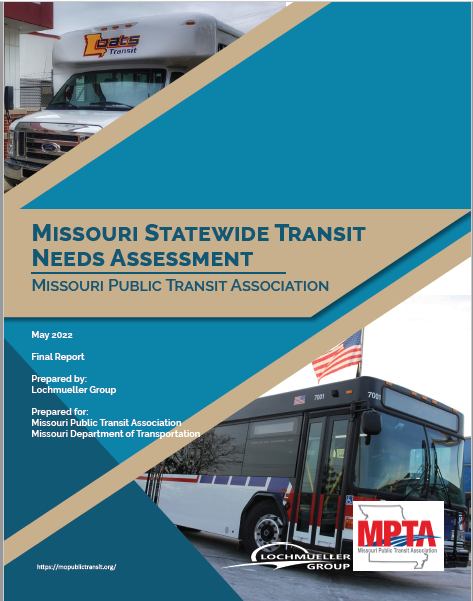The Missouri Public Transit Association (MPTA) released the findings of a Statewide Transit Needs Assessment Study commissioned by the Lochmueller Group – a full service, survey, planning, engineering and environmental firm – in partnership with the MPTA, its member agencies and the Missouri Department of Transportation (MoDOT). Over the last 10 months, this first-of-its-kind study examined public transit access across Missouri to help identify service gaps and operational needs, guide future mobility enhancements, prioritize investments and develop policies to better deliver transit service to customers and communities.
According to the study, 2,000 transit vehicles – operated by 4,500 workers – transport 156,000 riders every day in Missouri, yet there are unmet transit trip needs in virtually every corner of the state. Demand is especially acute for more rural areas that have non-programmed transportation needs or trips needed by individuals who do not qualify for Veterans Administration, Medicare and/or Medicaid. Urban areas are affected too as every operator and system throughout the state has some form of unmet needs. Total trips would need to increase by more than 39 million annually to meet derived demand estimates, costing more than $341 million a year in additional operating dollars.
Historically Missouri’s state funding has been only $0.28 per capita. Comparatively, the average transit investment of other states is $7.34 per capita. The Missouri legislature has recently approved $8.7 million, a historic level of funding not seen for more than two-decades, which increased the amount to $1.41 per capita. According to the study, concerted efforts will need to be made on the part of many stakeholders to ensure this level of investment occurs annually, and a significant amount of additional funding will need to be identified to attempt to reach the peer average and close the identified funding gap in Missouri.
Beyond funding, the study found that 34 transit operators face additional challenges, including a dire labor shortage. Increasing tightness in the labor market is an issue being felt across the transit industry, as well as other markets statewide and nationally. Recruiting, training and retaining drivers takes time and effort, and the pool of applicants is increasingly small. The same rings true for mechanics and vehicle maintainers. Vehicle needs are acute. These needs, which include vehicle replacements, are valued at more than $240 million dollars to meet the Federal Transit Administration useful life benchmark. Supply chain, microchip issues and Buy America requirements are exacerbating wait times for new vehicles even when funding is available. It takes two to five years from the time of ordering to the time for delivery, regardless of vehicle type.
“The goal of the study was to not only identify the current transit accessibility landscape, but to also provide direction for next steps,” stated Shawn Dikes, Senior Project Manager for the Lochmueller Group. “We worked to help identify short-term, mid-term and long-term recommendations to hopefully be accomplished in one to five years, six to 10 years and more than 10 years, respectively.”
On the funding front, the overall recommended goal is to increase funding for transit across the state to be more in line with funding levels of surrounding states. State matching funds for capital acquisitions – which are often vehicles – also needs to increase and there should be a $0 match for non-programmed rural transit providers since they have the most trouble procuring new vehicles and maintaining operations. Furthermore, the Lochmueller Group recommends the FTA 5311 reimbursement regulation that limits what can be counted as match and how MoDOT interprets the split for funding for 5311 operations and the reimbursement rate(s) be reexamined. Since this is a federal law, this could be a more complex and lengthy effort.
Snapshot data produced through this Statewide Transit Needs Assessment Study is essential, but additional data will need to be collected in a consistent manner in the future to reveal trends and needs more proactivley. It is also essential that factual data be disseminated and used for educational purposes among stakeholders, decision-makers, riders and the community at-large. Holding a Missouri Transit Summit focused on face-to-face networking to discuss technical issues and peer information exchange was also proposed.
It was also recommended that the Missouri Rural Transit Assistance Program (RTAP) be rescoped to take on an expanded role and perhaps be the premier program to conduct transit data collection, research and outreach. Regardless of who heads the effort, there is a need for a one-stop, Missouri-centric repository for all service areas and geographies, as well as the line data and attributes, that make up transit services. An online transit planning, estimation and stimulation tool – which integrates socio-economic, land use and transit network data into a platform for scenario-based transit ridership estimation and analysis – would also be crucial to have.
Incremental steps are recommended as it relates to service delivery, operations and assets. Transit providers and their partners and advocates should seek to fill 5 percent of unmet needs within five years, 7.5 percent within 10 years and 15 percent within 15 years. This would be an increase in the number of trips by approximately 1.9 million, 2.9 million and 3.9 million, respectively, in those timeframes. For non-programmed rural needs, this could be partially achieved by increasing the amount of revenue miles and hours that are delivered as this is the number of miles where vehicles are actively engaged in providing services. Lastly, Missouri should seek to replace vehicles in such a manner so that none of them are beyond useful life recommendations.
The Statewide Transit Needs Assessment Study can be accessed here. Information specific to all 34 transit providers in Missouri can be found in the study. Details relative to ridership, passenger and vehicles miles, operating funding sources and service efficiency and effectiveness for the 11 largest transit providers in the state can be found on pages 20-30 of the study.
The recent MPTA Education Series Webinar on the study can be seen here.
